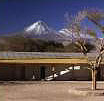Scientists hope that a remote lake on a dormant Chilean volcano can provide clues to what life may have been like in a far more distant place -- the planet Mars. Chilean volcano can provide clues to what life may have been like in a far more distant place -- the planet Mars. A 10-member team placed special plates in the lake on Licancabur volcano, at an altitude of 20,000 feet,on Sunday to measure the effects of ultraviolet light on organisms living there. The scientists, mostly from the United States, think learning how Licancabur organisms protect themselves may help researchers understand how life survived on early Earth and perhaps on early Mars as well. The damaging effects of UV radiation intensify at altitude and the air is very thin. And the lake is covered with ice most of the year, as would have been bodies of water on Mars. "If there was life on Mars 3.5 billion years ago, it could have used defense mechanisms similar to those used by the organisms at Licancabur volcano to survive," said team leader Nathalie Cabrol. The group, which includes science researchers from NASA and the SETI Institute, planned to spend two days at the lake, but weather conditions forced them to give up some of their research, which included a planned dive into the frigid lake. The mission also included geological experiments in the area around the volcano and testing a two-wheeled vehicle called "MARVIN," which may be used in future Mars missions. One of the group members said the experiments, were "very promising" but sediment and water samples would have to be analyzed in a laboratory before conclusions could be drawn. Another expedition will recover the UV plates next year. (Agencies) | 在智利火山的顶端,有一个静谧的湖泊。近来,科学家发现了它的新价值--也许,它能告诉人们在更遥远的火星,早期的生命是如何存在的。 11月10日,一个由10名科学家组成的小组在海拔2万英尺的利坎卡武尔火山顶端湖泊中放入了特殊的测量仪板,来测试紫外线照射当地的有机生物所产生的效果。 以美国科学家为主的许多科学家都认为,研究利坎卡武尔火山的有机生物如何自我保护能够启发人们认识在早期的地球,生物是如何生存下来的,甚至也可以由此类推到早期的火星生命形态上去。  在利坎卡武尔火山顶,紫外线辐射相当密集,杀伤力很强。空气也因为海拔高而非常稀薄,湖面上常年结着厚厚的冰层,与火星上的水域环境非常相似。 在利坎卡武尔火山顶,紫外线辐射相当密集,杀伤力很强。空气也因为海拔高而非常稀薄,湖面上常年结着厚厚的冰层,与火星上的水域环境非常相似。
研究小组的负责人纳塔莉·卡布罗尔说:"如果35亿年前火星上有生物的话,情况应该与利坎卡武尔火山顶生物生存下来所运用的防御机制大致相同。" 这个研究小组的成员主要来自美国国家宇航局(National Aeronautics and Space Administration)和美国寻找地外智能生命研究所(Search for Exterritorial Intelligence Institute, 简称SETI)。他们原计划在湖边度过两天,但迫于天气原因不得不放弃了部分研究项目,其中一项计划还要潜入到刺骨的湖水中完成。 原计划还包括在该火山地区进行地址勘测,以及测试一种名叫"MARVIN"的两轮运输车,这种车是为日后在火星进行勘测时使用而设计的。 一位研究组成员认为这次实验"非常有前景",但沉淀物和水样必须在实验室中经过化验才能得出实验的最后结论。明年,另一支研究队将被派往该地,收回紫外线测量仪板。 (中国日报网站译) |
